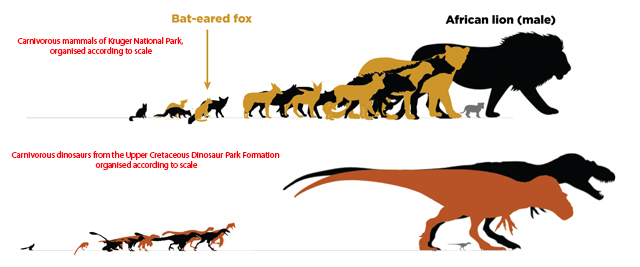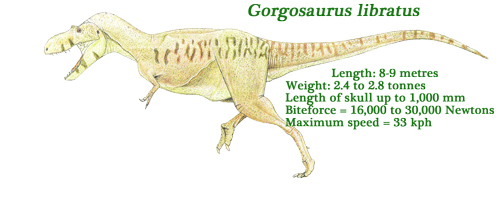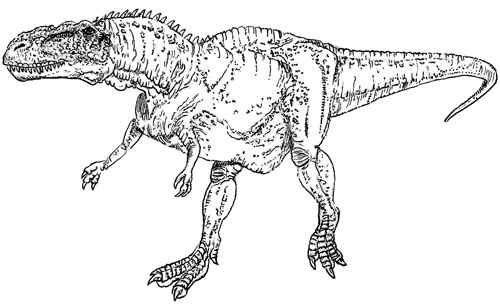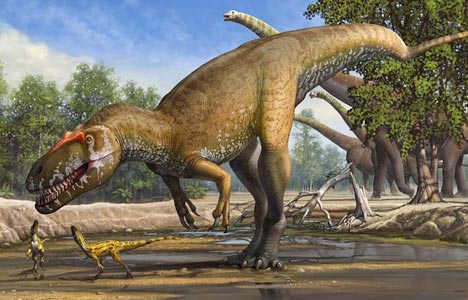Why So Few Medium-sized Carnivorous Dinosaurs?
Researchers from the University of Nebraska-Lincoln and University of New Mexico have come up with a novel explanation as to why there are so few medium-sized carnivorous dinosaurs found in the fossil record.
In a scientific paper published in the academic journal “Science” they propose that sub-adults and juveniles of much larger species out-competed similarly sized adults of medium-sized meat-eating dinosaurs resulting in a transformation of dinosaur community populations.
Comparing Mammalian and Dinosaurian Carnivorous Communities

Picture credit: Schroeder et al (Science)
Communities with Megatheropods Lacked Medium-sized Carnivores
The researchers identified that based on the known fossil record, communities of dinosaurs with super-sized theropods such as the Dinosaur Provincial Park fauna (Campanian faunal stage of the Late Cretaceous), lacked medium-sized carnivorous dinosaurs in the size range from 100 kilograms to 1,000 kilograms.
In contrast, modern mammalian communities such as that which exists on the savannah of Kruger National Park in South Africa have predators in a range of sizes, small ones such as mongooses, medium-sized species such as wild dogs as well as mega-carnivores such as leopards and lions. Each meat-eating species is able to exploit a food resource (prey animals). The distinctive biology of the Dinosauria wherein, all predators hatched from eggs so started out as tiny in size perhaps less than ten kilogrammes for even the largest tyrannosaurids, may have led to a fundamental shift in predator community dynamics.
Rapidly growing juveniles and sub-adults of the larger species could have out-competed the fully grown medium-sized carnivores (mesocarnivores).
Gorgosaurus libratus – An Apex Predator of the Dinosaur Park Formation

Picture credit: Everything Dinosaur
Lead author PhD student Katlin Schroeder (University of New Mexico), explained:
“Dinosaur communities were like shopping malls on a Saturday afternoon — jam-packed with teenagers. They made up a significant portion of the individuals in a species and would have had a very real impact on the resources available in communities.”
Compiling Physiological Data on Dinosaur Dominated Ecosystems
The researchers compiled physiological and fossil data on more than 550 different dinosaur species from 43 different dinosaur dominated ecosystems. They found that there was an absence of mesocarnivores. The scientists concluded that it was the teenage megatheropods that created and filled this gap in the community. After dividing this 100 to 1,000 kilogram gap into different weight categories, they found that juvenile megatheropods made up more than 50% of the total dinosaur biomass in every weight class. This is like a boxer destined to be the heavyweight champion dominating the bantam, lightweight and middleweight classes during their rise to the top.
Abelisaurids Also Drove out Mesocarnivores

Picture credit: Everything Dinosaur
Driving Out the Medium-sized Meat-eaters
Although herbivorous dinosaurs were found in a range of different body sizes, including medium-sized ones, the team concluded that when it came to the meat-eaters, the way in which large carnivorous dinosaurs grew was an important factor that helped shape dinosaur community structure and diversity.
Co-author of the study, Kate Lyons (Assistant Professor of Biological Sciences at the University of Nebraska-Lincoln), added that the research:
“Essentially says that megatheropods were consuming 50% or more of the energy available to dinosaurs at a respective body size, leaving very little for other species to consume. If they were consuming the majority of the energy at that body size, then they were going to be outcompeting anything else that might try to feed at that size, as well.”
A Difference in Jurassic and Cretaceous Dinosaur Communities
It was noted that there was a subtle difference between dinosaur communities from the Jurassic with those from the Cretaceous. Generally, there were smaller gaps in the size range of carnivorous dinosaurs during the Jurassic when compared to the size gap seen in later communities dating from the Cretaceous.
Katlin Schroeder postulated that this difference came about because:
“Jurassic megatheropods don’t change as much, the teenagers are more like the adults, which leaves more room in the community for multiple families of megatheropods as well as some smaller carnivores. The Cretaceous, on the other hand, is completely dominated by tyrannosaurs and abelisaurs, which change a lot as they grow.”
Jurassic Ecosystems

Picture credit: Sergey Krasovskiy
The scientific paper: “The influence of juvenile dinosaurs on community structure and diversity” by Katlin Schroeder, S. Kathleen Lyons and Felisa A. Smith published in Science.
Visit the Everything Dinosaur website: Everything Dinosaur.

